The Golden Dawn or Thoth Method
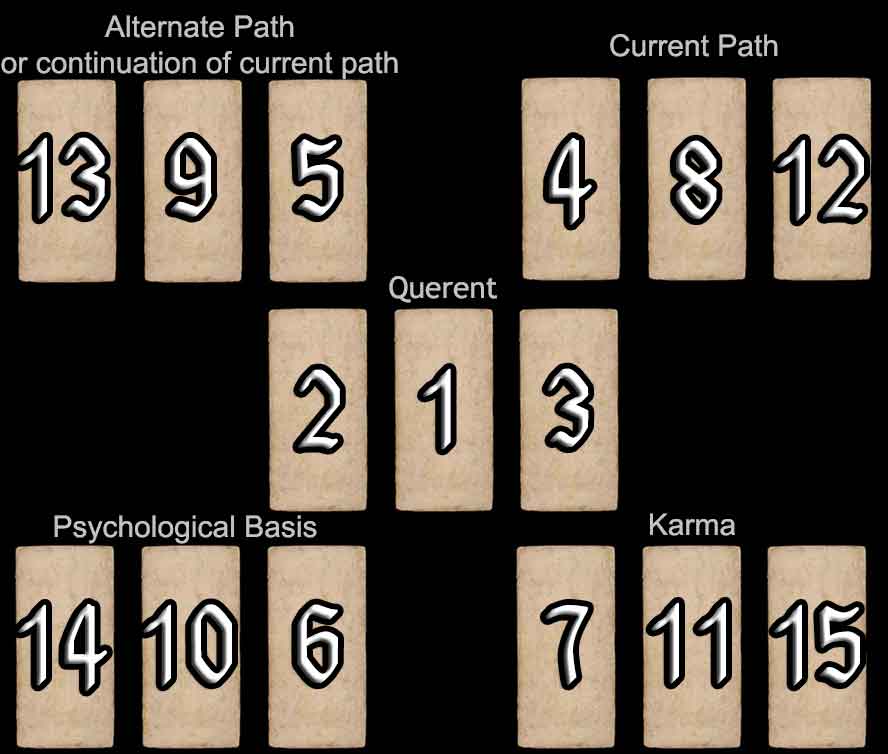
Difficulty: Complicated
Note: Tarot decks that use reversed cards such as the Rider-Waite do not work well with this spread, which was designed to be read using elemental dignity.
The Golden Dawn spread is best suited for use with the bifrost Tarot and especially the Book of Thoth, as these decks are meant to be read a certain way with the court cards. Princes and queens represent actual men and women connected with the matter, while princesses generally represent ideas; thoughts or opinions, and knights represent arrival or departure of a matter depending on the direction faced.
In this tarot spread, particular attention should be paid to a card's exact position in relation to its neighbours. Whether the neighbour cards bear the same energy (suit) determines whether a card is considered well-dignified or ill-dignified. Opposite suits ill-dignify each other, while other suits are considered friendly. Tarot cards of the same suit or element strengthen each other.
As with other tarot spreads, it is important to count the cards' tendencies, such as whether there is a lot of one particular suit or number pattern. The patterns reveal special messages. Having several majors present indicates higher forces at work, several cups suggest strong emotions, etc.
Card #1 represents the reader and the nature of the topic at hand.
Cards #2 & #3 are read in extension of #1 to further comprehend the nature of the topic.
The two sets of three tarot cards at the top of the spread represent chronological sets of events. The current path as it would unfold naturally is represented by cards #4, #8, & #12. The alternate path that could be taken is represented by cards #13, #9, & #5. However, if the reader gets the feeling these cards are telling them they go together, then the alternate path is to be considered an extension of the current path, and to be read chronologically in this order: #4, #8, #12, #13, #9, #5. Just keep in mind: this is only if the two paths seem particularly similar.
Cards #14, #10, & #6 shed light upon the psychological undertones of the current issue.
Cards #7, #11, & #15 represent the influences of karma and destiny beyond the reader's control. These cards suggest adapting to this, as fate.
Your Golden Dawn Reading
| The Alternate Path (or Extension of Current Path) |
Your Current Path |
|||||
XVI – The Tower (Lost card, substituted here) |
XIII – Death |
XV – The Devil (Lost card, substituted here) |
II – The Popess |
I – The Magician |
V – The Pope |
|
| The Querent | ||||||
XIV – Temperance |
IV – The Emperor |
XIX – The Sun |
||||
| The Psychological Basis | Karma | |||||
VI – The Lovers |
XXI – The World |
XVIII – The Moon |
VII – The Chariot |
X – The Wheel of Fortune |
0 – The Fool |
|
The Querent
cards represent the querent and the nature of the topic at hand. The first card (in the center of the spread) represents the very core of the matter, and the other two cards around it are added to it in order to further comprehend the nature of the topic.
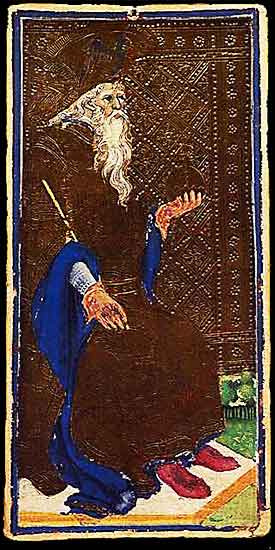
The Emperor symbolises structure, authority, and stability. He represents the power of rules and order to create security and success, though sometimes at the expense of flexibility.
Symbolism: Seated upright with a sceptre and orb, the Emperor exudes control and dominion. His luxurious robes and the golden background emphasise his regal and unshakable power. His stillness reflects his role as a protector of order and enforcer of discipline.
In Relationships: A relationship built on structure and commitment. It can suggest the presence of a protective partner or the need to establish boundaries.
In Work: Leadership, organisation, and discipline are essential for achieving success. The Emperor encourages taking control and assuming responsibility.
Spiritually: The Emperor teaches the importance of structure and discipline in spiritual practice, encouraging grounded growth.
When ill-dignified: Tyranny, rigidity, or abuse of power. It warns against controlling behaviours or excessive adherence to rules.
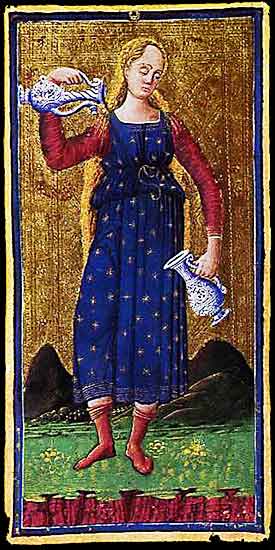
Temperance represents harmony, balance, and the art of blending opposites. It suggests a time of calm, careful moderation, and the synthesis of differing energies into a cohesive whole.
Symbolism: Pouring liquid from one vessel to another symbolises the balance and exchange between opposing forces—emotion and intellect, fire and water, inner and outer worlds. Her graceful posture and tranquil demeanour indicate deliberate action, emphasising that peace comes through moderation. The golden background elevates balance to the divine level, suggesting that harmony is sacred.
In Relationships: Temperance encourages balance in relationships. It asks for patience and moderation in interactions, fostering an environment where both partners can harmonise their differences.
In Work: Success comes through collaboration and maintaining equilibrium. This card advises you to blend your talents with those of others, seeking compromise rather than extremes.
Spiritually: Temperance represents spiritual equilibrium. It calls for integrating the material and spiritual worlds, balancing one's desires and needs for peace and alignment.
When ill-dignified: Imbalance, excess, or a lack of harmony. This could indicate dissonance in relationships, career, or spiritual practice, warning against overindulgence or extremes.
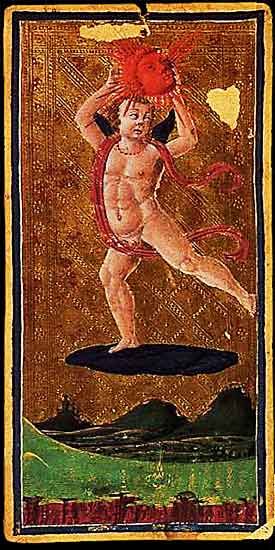
The Sun represents vitality, clarity, and joyful achievement. It signifies success, enlightenment, and the unyielding energy of optimism and truth.
Symbolism: The child holding the radiant red head is a symbol of pure, untainted joy and triumph. The energetic movement of the figure contrasts with the calm, golden background, reflecting the vitality and dynamic energy of the Sun. This is a card of achievement, where obstacles are overcome through innocence, optimism, and a radiant spirit.
In Relationships: The Sun brings clarity and happiness. It suggests a time of positivity, joy, and mutual growth, where the light of truth shines on all interactions.
In Work: Success and fulfilment are on the horizon. The Sun encourages you to take confident action and bask in the warmth of your accomplishments.
Spiritually: Enlightenment and clarity. The Sun symbolises spiritual illumination, urging you to embrace your true self and the divine light within you.
When ill-dignified: Overconfidence, arrogance, or an inability to see things clearly. The Sun reversed may signal excess or an inflated ego, blinding one to the truth.
Your Current Path
cards represent your current path as it would unfold naturally. These cards are read in chronological order from left to right.
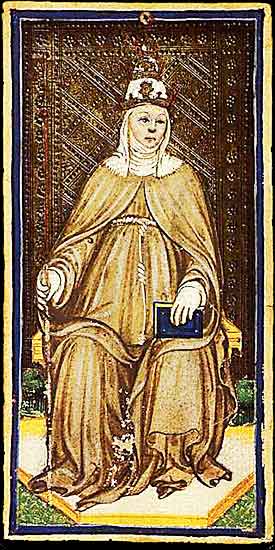
The Popess signifies intuition, mystery, and hidden wisdom. She represents the need to look inward and trust one's inner voice while respecting the unknown and unseen.
Symbolism: Her veil and book symbolise the sacred mysteries she guards. The golden background elevates her presence, while her fancy robes reflect the complexity of her spiritual knowledge. Her composed demeanour conveys her role as a keeper of divine truths.
In Relationships: A time to trust your instincts. The Popess may suggest unspoken feelings or the need for patience.
In Work: Hidden opportunities or knowledge may come to light. Use intuition and discretion when making decisions.
Spiritually: A call to explore inner wisdom and the mysteries of life. Trust the subtle guidance of intuition.
When ill-dignified: Secrets, deception, or an overreliance on logic at the expense of intuition.
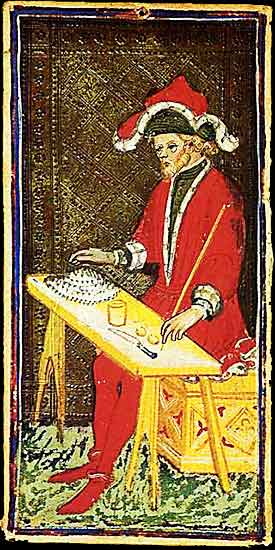
The Magician embodies skill, potential, and the power to manifest. He represents the mastery of tools and resources, as well as the confidence to create one's reality. This card speaks of the importance of focus and action in shaping personal success.
Symbolism: The Magician's table holds simple tools, symbolising practical skills and raw materials. His Renaissance attire conveys refinement and expertise, while the golden background suggests his elevated role in shaping the material world. His seated position emphasises composure and control over his craft.
In Relationships: A call to use charm and communication to strengthen relationships. It warns of manipulation if ill-intentioned.
In Work: A time to take initiative and harness your abilities to achieve success. The Magician encourages innovation and confidence.
Spiritually: The Magician bridges the physical and spiritual, reminding the seeker to channel divine inspiration into practical actions.
When ill-dignified: Misuse of skills, deception, or scattered energy. It warns against overconfidence or manipulation.
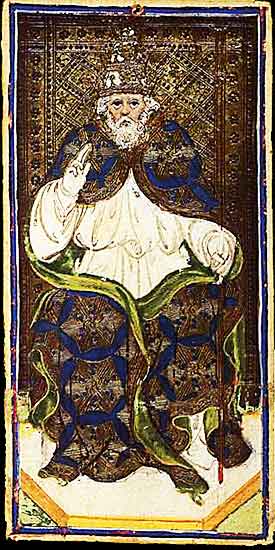
The Pope represents tradition, spiritual authority, and shared values. He embodies the connection between divine wisdom and earthly institutions, urging adherence to established principles.
Symbolism: The Pope's raised hand conveys blessing, while his staff with a triple cross represents divine authority. The kneeling figures at his feet highlight devotion and the transmission of sacred teachings. The symmetrical composition and golden background reinforce his role as a stabilising spiritual guide.
In Relationships: A union founded on shared values or traditions. It may suggest the influence of societal expectations on relationships.
In Work: Success comes through adherence to established systems or mentorship from a trusted authority figure.
Spiritually: The Pope urges respect for spiritual traditions and the wisdom passed down through generations.
When ill-dignified: Dogma, blind conformity, or resistance to innovation. It cautions against rigid adherence to outdated ideas.
The Alternate Path
cards represent the alternate path that you could choose to take in lieu of the Current Path. However, if the cards that come up seem to indicate that they go along with the Current Path, these three cards should be interpretted not as an Alternate Path, but as a chronological extension of the Current Path (also read from left to right).
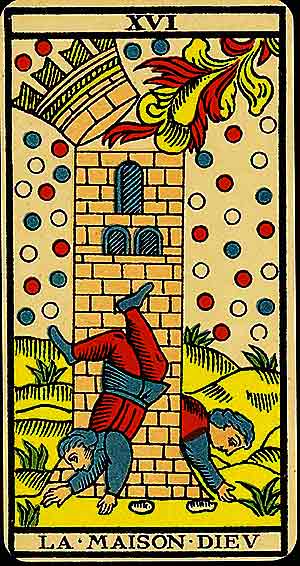
This card no longer exists, so the Marseille version is filling in. The Tower symbolises upheaval, sudden change, and the destruction of false structures. It heralds moments of revelation that, while shocking, clear the way for growth and truth.
Symbolism: The lightning bolt represents divine intervention shattering illusions and falsehoods. The crumbling tower signifies the collapse of unstable foundations. The falling figures illustrate vulnerability and the inevitability of change, while the broken shield reflects the fragility of ego and human constructs. Despite the chaos, the background suggests this upheaval is necessary for enlightenment.
In Relationships: The Tower signals a sudden shake-up, possibly a breakup or revelation. Though painful, it clears the way for honesty and authenticity.
In Work: Expect abrupt changes, such as a job loss or major restructuring. Though unsettling, this card pushes you to re-evaluate your priorities and rebuild stronger foundations.
Spiritually: The Tower challenges false beliefs and spiritual stagnation. A moment of crisis will lead to profound insight and transformation.
When ill-dignified: When reversed or ill-dignified, the Tower suggests avoiding necessary change, delaying the inevitable, or clinging to a crumbling situation. It warns that resisting transformation can lead to prolonged suffering.
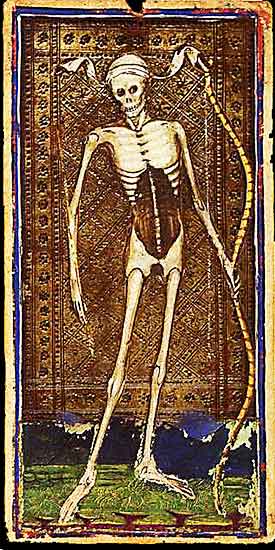
Death signifies the inevitable conclusion of one cycle and the heralding of another. It's a powerful symbol of transformation, renewal, and the necessity of endings to foster new beginnings.
Symbolism: The skeletal figure with a scythe represents the impartial and unrelenting nature of time and change. The image of fallen bodies suggests the end of a phase, but the subtle floral designs interwoven with the scene offer hope, symbolising rebirth and the cyclical nature of existence. The golden background emphasises the universal truth of transformation and the inevitability of all life cycles.
In Relationships: This card suggests the end of an old emotional pattern or relationship, clearing the way for renewal. Let go of what no longer serves you to make space for new, healthier connections.
In Work: Death marks the close of one professional chapter. It's a time for endings, making way for new opportunities and growth. Embrace the transition instead of fearing it.
Spiritually: Death calls for a transformation, letting go of old beliefs or attachments. Spiritual rebirth requires an embrace of the unknown and a surrender to the cycles of existence.
When ill-dignified: Resistance to change, stagnation, and fear of letting go. This can manifest as clinging to the past or an inability to move forward, hindering growth.
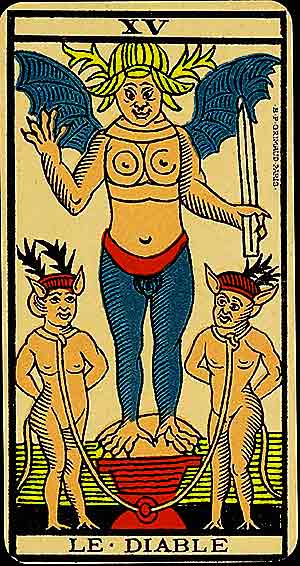
This card no longer exists, so the Marseille version is filling in. The Devil represents bondage, temptation, and the shadow self. It highlights the chains we impose upon ourselves through fear, obsession, or indulgence, urging us to confront these darker aspects to reclaim our freedom.
Symbolism: The Devil embodies primal instincts and the seduction of material or carnal desires. The chained figures symbolise voluntary entrapment, their loose bindings reminding us of the ability to escape our vices. The pedestal signifies false power, while the scene hints at the potential for redemption through self-awareness.
In Relationships: The Devil warns of unhealthy attachments, jealousy, or manipulative relationships. It challenges you to examine whether passion has turned into obsession.
In Work: This card can signify being trapped in a toxic work environment, greed, or overreliance on material success. It urges you to reflect on what fulfils you.
Spiritually: The Devil calls for self-awareness and shadow work. Confronting your inner fears or desires will lead to personal liberation.
When ill-dignified: When reversed or ill-dignified, the Devil signifies breaking free from constraints, overcoming addiction, or realising what binds you.
The Psychological Basis
cards shed light upon the psychological undertones of the current problem.
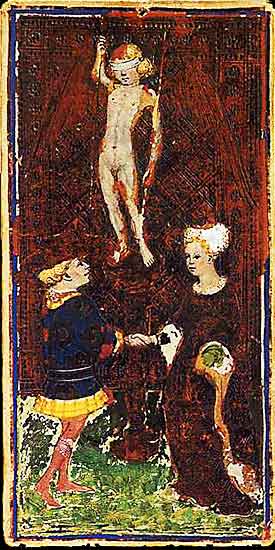
The Lovers represent choice and the uniting of opposites. It embodies the transformative power of love and the necessity of making meaningful decisions.
Symbolism: The young couple standing beneath Cupid symbolises connection and divine guidance in love. The formal Renaissance clothing and the golden background elevate their union to a sacred level, while the static composition emphasises balance and deliberate choice.
In Relationships: A powerful connection that unites hearts and souls. It may signify a new relationship or a pivotal choice in love.
In Work: A partnership or decision with far-reaching consequences. The Lovers encourage the alignment of values with your work.
Spiritually: The Lovers symbolise unity with your higher self and the harmonious integration of opposites.
When ill-dignified: Temptation, discord, or indecision. It warns against superficial connections or poor choices.

The World represents completion, wholeness, and the harmonious integration of all aspects of life. It is the last card of the Major Arcana, signalling the end of one journey and the beginning of another.
Symbolism: The two ethereal figures holding the globe or portal represent the union of duality and the achievement of balance. The rolling plains and distant mountains beneath the golden sky symbolise the vast potential of the world, and the figures' gesture of offering suggests a celebration of accomplishment. The card evokes cosmic harmony, completion, and the endless cycles of existence.
In Relationships: The World signifies a complete and fulfilling relationship, one where both partners are in harmony and balanced with each other. It's a time of celebration and unity.
In Work: Completion of a major goal or project. The World indicates the successful culmination of efforts, with new horizons opening up in your professional life.
Spiritually: A time of wholeness. The World signifies a sense of fulfilment and oneness with the universe, representing the final stage of spiritual evolution.
When ill-dignified: Incompletion, being stuck, or an inability to move forward. This card warns of a lack of closure or an unfinished journey that hinders your growth.
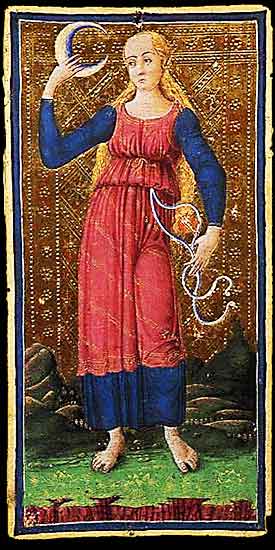
The Moon is the card of intuition, illusion, and the subconscious. It calls attention to hidden truths, dreams, and the mysterious undercurrents that govern one's emotional landscape.
Symbolism: The barefoot woman holding a crescent moon reflects the card's connection to the primal, intuitive side of the psyche. Her gaze towards the sky suggests an awareness of the mysteries beyond the surface of reality. The wild, untamed landscape beneath her speaks to the untapped and often misunderstood forces of the unconscious mind. The golden background heightens the mystical quality, suggesting the moonlight reveals hidden paths.
In Relationships: The Moon indicates that not everything is as it seems in your romantic life. Trust your intuition, but also be cautious of illusions or deceptions.
In Work: Hidden factors or unclear circumstances may influence your professional life. The Moon calls for careful introspection and a deeper understanding of the forces at play.
Spiritually: This card calls for exploring the subconscious and trusting your intuitive wisdom. There may be deep truths that need to be uncovered.
When ill-dignified: Confusion, illusion, or deception. This warns of misunderstandings or hidden motives that could lead to emotional instability or false perceptions.
Karma
These cards represent the influences of karma and destiny that are beyond your control. They suggest adapting to this fate.
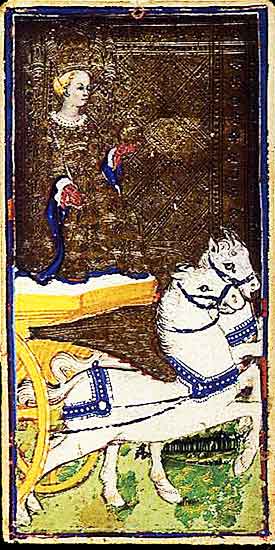
The Chariot symbolises determination, willpower, and triumph through self-discipline. It represents the ability to move forward and achieve success by mastering conflicting forces.
Symbolism: The stationary horses reflect control rather than speed, while the charioteer's detailed attire and golden background emphasise victory and refinement. The calm pose suggests strength in discipline over chaos.
In Relationships: A time to take charge of your relationship's direction. The Chariot signals progress but warns against domination.
In Work: Triumph through focus and determination. It's a call to harness all resources and overcome obstacles confidently.
Spiritually: The Chariot encourages the mastery of inner conflicts to progress along the spiritual path.
When ill-dignified: Loss of direction, lack of control, or excessive force. It warns against being carried away by ambition or unchecked emotions.
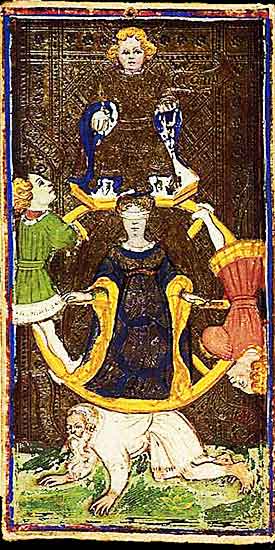
The Wheel of Fortune signifies cycles, fate, and the ever-changing nature of life. It reminds us of the importance of adaptability and acceptance in the face of change.
Symbolism: Figures ascending and descending on the wheel represent the ups and downs of life. The patterns add richness to the composition, while the golden background underscores the divine and inevitable nature of change.
In Relationships: A turning point in relationships, whether for better or worse. The Wheel reminds us to embrace change.
In Work: Unexpected opportunities or setbacks. It advises adaptability and resilience in navigating shifting circumstances.
Spiritually: The Wheel teaches surrender to the cycles of life and faith in the greater plan of the universe.
When ill-dignified: Resistance to change, bad luck, or repeating cycles. It warns against clinging to the past or fearing the future.

The Fool symbolises new beginnings, innocence, and an open-hearted journey. He represents the spirit of adventure and trust in the unknown, unburdened by experiences or material concerns. His path is one of discovery, where curiosity leads the way.
Symbolism: The vagabond's tattered clothing reflects detachment from societal norms, while his staff and bundle suggest minimal baggage—both physical and emotional. The golden background highlights his eternal and universal journey. His carefree, open-mouthed expression conveys both the naivety of youth and the wisdom of freedom from expectations.
In Relationships: A signal to take risks or approach relationships with spontaneity and trust. It cautions against naivety or reckless behaviour.
In Work: An invitation to embrace a new path or project with an open mind. The Fool encourages experimentation and trust in one's instincts.
Spiritually: The Fool represents faith in the journey ahead and the courage to step into the unknown. He invites the seeker to trust the divine flow.
When ill-dignified: Foolishness, poor judgement, or recklessness. It warns against ignoring practicalities or rushing ahead blindly.